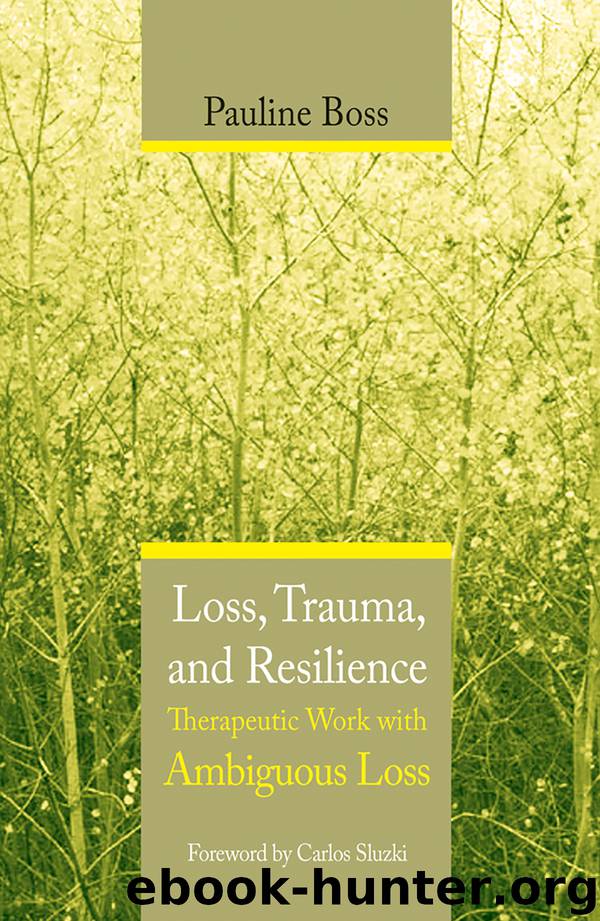Loss, Trauma, and Resilience by Pauline Boss

Author:Pauline Boss
Language: eng
Format: epub
Publisher: W. W. Norton & Company
Published: 2018-06-14T16:00:00+00:00
WHAT HINDERS?
The following factors and conditions hinder the reconstruction of identity after the trauma of ambiguous loss.
Discrimination and Stigma
Among the most deleterious contexts in which to reconstruct identity after the trauma of ambiguous loss are those that stigmatize and discriminate against race, color, class, sexual orientation, disability, gender, age, religion, and culture. At fairly young ages we know where we are on this list and how the community around us views the list. Whether in school, on the job, in the clinic, or at our place of worship, we know early on whether or not a person’s identity fits family and community expectations. Schoolmates may yell stigmatizing epithets or ossify identities by labeling—the retard, the jock, the bimbo, the druggie, the nerd. Too often others in the community don’t look beyond the prejudiced identities. The problem worsens as the stigmatized persons shape their own identities by how others see and treat them. In this instance, seeing one’s self in the eyes of others has a negative influence on identity construction and reconstruction.
According to O’Brien and Kollock, examples of stigmatized identities are the homeless, mental patients, the poor, and people with unpopular religious beliefs, with the most stigmatized identities being “handicapped, homeless, ex-convict, hooker, drug addict, mental patient, [and] welfare recipient” (2001, p. 500). In many communities, stigma still follows the identities of gay, lesbian, bisexual, and transgendered people. Many people of color still face discrimination and the stigma of racial slurs. It is important for professionals to understand that some identities, because they are stigmatized, cause ambiguous losses. Culturally and personally, prejudice can bring shame and the impulse to hide one’s authentic identity from others. Interaction is stifled and trust is rare. In this way, stigma and discrimination hinder resilience.
In some cases people who have suffered stigma, prejudice, discrimination, and genocide change their identities to pass as someone other than who they are. Passing as straight, as white, as a man or a woman—all may be related to safety and reconstructing an identity to escape a stigmatized identity (Crawford, 1993; Kroeger, 2003). Whatever the reason, trying to maintain an inauthentic identity strains resiliency and health.
Download
This site does not store any files on its server. We only index and link to content provided by other sites. Please contact the content providers to delete copyright contents if any and email us, we'll remove relevant links or contents immediately.
Rewire Your Anxious Brain by Catherine M. Pittman(17585)
Talking to Strangers by Malcolm Gladwell(11875)
The Art of Thinking Clearly by Rolf Dobelli(8840)
Mindhunter: Inside the FBI's Elite Serial Crime Unit by John E. Douglas & Mark Olshaker(7833)
Becoming Supernatural by Dr. Joe Dispenza(7103)
Change Your Questions, Change Your Life by Marilee Adams(6639)
Nudge - Improving Decisions about Health, Wealth, and Happiness by Thaler Sunstein(6633)
The Road Less Traveled by M. Scott Peck(6633)
The Lost Art of Listening by Michael P. Nichols(6469)
Enlightenment Now: The Case for Reason, Science, Humanism, and Progress by Steven Pinker(6405)
Win Bigly by Scott Adams(6310)
Mastermind: How to Think Like Sherlock Holmes by Maria Konnikova(6233)
The Way of Zen by Alan W. Watts(5798)
Daring Greatly by Brene Brown(5639)
Grit by Angela Duckworth(4734)
Big Magic: Creative Living Beyond Fear by Elizabeth Gilbert(4723)
Men In Love by Nancy Friday(4319)
Flow by Mihaly Csikszentmihalyi(4051)
The Four Tendencies by Gretchen Rubin(4024)
